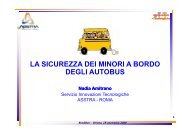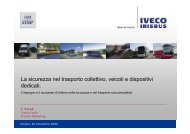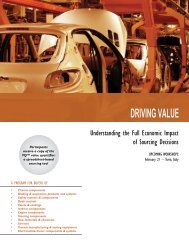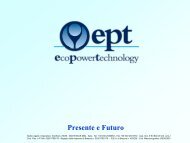Nadia Amitrano, Servizio Innovazioni Tecnologiche ASSTRA - Anfia
Nadia Amitrano, Servizio Innovazioni Tecnologiche ASSTRA - Anfia
Nadia Amitrano, Servizio Innovazioni Tecnologiche ASSTRA - Anfia
Create successful ePaper yourself
Turn your PDF publications into a flip-book with our unique Google optimized e-Paper software.
L’AUTOBUS DEL FUTURO E LE<br />
SPECIFICHE FUNZIONALI RICHIESTE<br />
<strong>Nadia</strong> <strong>Amitrano</strong><br />
<strong>Servizio</strong> <strong>Innovazioni</strong> <strong>Tecnologiche</strong> <strong>ASSTRA</strong>
CHI SIAMO<br />
<strong>ASSTRA</strong> nasce il 1 gennaio 2001 dalla<br />
fusione di<br />
FENIT<br />
Federazione<br />
Nazionale<br />
Imprese<br />
Trasporti<br />
Bus&Bus – Verona, 18 novembre 2009<br />
2
CHI SIAMO<br />
<strong>ASSTRA</strong> rappresenta pp una rete di più p di 200 Aziende di TPL, che svolgono g<br />
servizio urbano, suburbano ed extraurbano attraverso:<br />
�Autobus,<br />
�Tram,<br />
�Filobus,<br />
�Metropolitane<br />
�Metropolitane,<br />
�Ferrovie regionale(Eccetto quelle operate da Trenitalia S.p.A.),<br />
�Servizi �Servizi scolastici e turistici turistici,<br />
�Parcheggi,<br />
�<strong>Servizio</strong> <strong>Servizio</strong> di rimorchio veicoli.<br />
Bus&Bus – Verona, 18 novembre 2009<br />
3
I PRINCIPALI DATI DI <strong>ASSTRA</strong><br />
I PRINCIPALI DATI DELLE AZIENDE ADERENTI AD <strong>ASSTRA</strong><br />
Membri associati 217<br />
Quota di mercato trasporto urbano 95%<br />
Quota di mercato trasporto extraurbano 75%<br />
Mezzi di trasporto (gomma e metropolitano) 37.000<br />
Ferrovie regionali 830 treni<br />
Estensione rete 210.000 km<br />
Chilometri prodotti p 1,65 , miliardi<br />
Addetti 100.000<br />
Comuni serviti 5.000<br />
Passeggeri trasportati 5,2 miliardi<br />
15 milioni/giorno<br />
Totale valore della produzione p<br />
8 miliardi €<br />
[Fonte: Elaborazioni <strong>ASSTRA</strong>, Annuario <strong>ASSTRA</strong>- Anno 2008]<br />
Bus&Bus – Verona, 18 novembre 2009<br />
4
Total<br />
Other<br />
Electric<br />
Hybrids<br />
GPL<br />
Methane<br />
Diesel<br />
89<br />
356<br />
356<br />
89<br />
L’OFFERTA DEI VEICOLI DI TPL<br />
TIPOLOGIA<br />
Bus<br />
Filobus<br />
Tram<br />
Metropolitana<br />
1601<br />
TOTAL<br />
N° Bus I Class<br />
(Asstra-Data 2005)<br />
AFFERENTI AD <strong>ASSTRA</strong><br />
15301<br />
0 3000 6000 9000 12000 15000 18000<br />
NN. VEICOLI<br />
17792<br />
34.375<br />
454<br />
957<br />
1.298<br />
37.000<br />
Total<br />
Other<br />
Electric 16<br />
Hybrids3<br />
GPL 5<br />
Methane0<br />
Diesel<br />
Bus&Bus – Verona, 18 novembre 2009<br />
31<br />
FONTE<br />
<strong>ASSTRA</strong> (2006)<br />
<strong>ASSTRA</strong>(2008)<br />
CNT 2006-07<br />
CNT 2006-07<br />
N° Bus II Class<br />
(Asstra-Data 2005)<br />
0 4000 8000 12000 16000<br />
15527<br />
15511<br />
5
Il progetto p g EBSF<br />
Progetto in collaborazione nel settore della Ricerca e Trasporto,<br />
sugli autobus urbani e suburbani<br />
Promosso e finanziato<br />
dalla UE<br />
Fa parte del Settimo Programma<br />
Quadro della Direzione-Generale per<br />
la Ricerca de l’UE<br />
Coordinato dalla Durata 4 anni 47 Partecipanti p<br />
UITP (2008 (2008-2011) 2011) 11 Paesi Europei<br />
Bus&Bus – Verona, 18 novembre 2009<br />
6
Membri del Progetto g<br />
classificati per famiglia di stakeholder<br />
Costruttori Evobus Evobus, Irisbus Irisbus, Neoman Neoman, Scania Scania, Volvo<br />
Aziende di supporto pp<br />
Aziende di TPL<br />
Autorità organizzatrici<br />
Associazioni di TPL<br />
Società di ricerca e di<br />
consulenza<br />
Actia, , INIT, , Hübner, , Hogia, g , Digigroup, gg p,<br />
Ineo, Pilotfish, Vultron<br />
BKV Budapest, Bremerhaven Bus, RATP, ATV Verona,<br />
Veolia Veolia, RATB Bucharest Bucharest, SRWT Namur Namur, Trambus Rome Rome,<br />
ATM Milan<br />
Gothenburg, Lyon, Nantes, Madrid<br />
<strong>ASSTRA</strong>, KNV, VDV, UTP, UITP<br />
D’Appolonia, Helmut, CERTU, Chalmers, Fraunhofer,<br />
PolitécnicaMadrid, FIT, Newcastle Univ.,PE Int.,INRETS,<br />
Uni Roma TRE, Uni Roma UNO, TIS.PT, CEIT, CRF,TEKIA<br />
Bus&Bus – Verona, 18 novembre 2009<br />
5<br />
8<br />
9<br />
4<br />
5<br />
16<br />
7
Membri del Progetto<br />
classificati per nazione<br />
<strong>ASSTRA</strong>, ATV Verona, CRF, D’Appolonia, Digigroup, FIT,Uni<br />
Roma TRE, Uni Roma UNO, Trambus Roma, ATM Milano<br />
Actia, CERTU, Ineo, INRETS, Irisbus, Lyon, Nantes, RATP, UTP<br />
Bremerhaven Bus, Evobus, Fraunhofer, Helmut, Hübner, INIT,<br />
Neoman, PE Int. VDV<br />
Chalmers, Gothenburg, Hogia, Pilotfish, Scania, Volvo<br />
SRWT Namur,<br />
UITP<br />
CEIT, Madrid, Politécnica Madrid, TEKIA<br />
BKV Budapest,<br />
Vultron<br />
RATB<br />
Newcastle<br />
Bucarest<br />
University<br />
Bus&Bus – Verona, 18 novembre 2009<br />
KNV<br />
10<br />
10<br />
9<br />
6<br />
4<br />
2+2+1<br />
TIS TIS.PT PT<br />
1+1+1<br />
8
Il Sistema Europeo<br />
dell’autobus del futuro<br />
Bus&Bus – Verona, 18 novembre 2009<br />
9
Validation/Test<br />
Operators/<br />
Authorities/<br />
Industry<br />
General Project Process<br />
Assessment of user<br />
needs/requirements<br />
Construction<br />
Industry<br />
Bus&Bus – Verona, 18 novembre 2009<br />
Operators/<br />
Authorities<br />
Development of<br />
technological<br />
concepts<br />
Industry<br />
10
Project Managem M ment<br />
SP0 –<br />
Struttura del Progetto<br />
SP1 – Bisogni degli attori del TPL (User needs) needs), KPIs e<br />
approccio al sistema autobus europeo.<br />
Sintesi dei requisiti e dell’architettura del sistema<br />
SP2<br />
Implementazione del<br />
veicolo i l nel l sistema i t<br />
autobus.<br />
Sviluppo e<br />
Implementazione<br />
p<br />
SP3<br />
Sistema Autobus nel<br />
contesto t t urbano b<br />
(infrastruttura ed<br />
esercizio)<br />
Sviluppo e<br />
iimplementazione l t i<br />
SP4 – Testare Testare, valutare, valutare diffondere e utilizzare<br />
Bus&Bus – Verona, 18 novembre 2009<br />
11
SP0<br />
Il Ruolo di <strong>ASSTRA</strong><br />
WP 00.1 1 2<br />
WP 1.1 7<br />
SP1<br />
WP 1.3<br />
WP 1.4<br />
2<br />
8<br />
Leader<br />
WP 1.5 2<br />
WP 1.6 3<br />
SP2<br />
WP 2.2 2<br />
WP 2.6 2<br />
WP 3.1 3<br />
SP3<br />
WP 3.2 2<br />
WP 3.3 3<br />
WP 4.1 24<br />
Leader<br />
SP4<br />
WP 4.2<br />
WP 4.3<br />
2<br />
4<br />
WP 4.4 2<br />
WP 4.5 1<br />
Bus&Bus – Verona, 18 novembre 2009<br />
12
SP1- User Needs, Classification, KPIs and<br />
System Approach to the EU Bus System<br />
WP1.1<br />
User Needs, KPIs<br />
WP1.3<br />
Overall System<br />
Requirements<br />
WP1.4<br />
WP1.5<br />
Vehicle Requirements Infrastructure<br />
Requirements<br />
SP1 Structure<br />
Bus&Bus – Verona, 18 novembre 2009<br />
WP1.6<br />
Operation Requirements<br />
WP1.2<br />
Environment for Project<br />
Evaluation<br />
13
VEHICLE<br />
SP2 - Vehicle Implementation of the<br />
EU Bus System<br />
WP2.1: Accessibility-Flow-Layout-Speed<br />
WP2.2: Driver role, Ergonomic<br />
WP2.3: On board Information system<br />
WP 2.4: Handling<br />
SSupport pport systems s stems (G (Guidance, idance …) )<br />
WP2.5: Modularity<br />
WP2.6:<br />
Environment/Energy Saving/HVAC<br />
WP2.7: Commissioning of prototype<br />
Volvo Irisbus Neoman EvoBus Scania<br />
Eurolum<br />
Fraunhofer<br />
Dapp<br />
Concept vehicle (sub-systems)<br />
Bus&Bus – Verona, 18 novembre 2009<br />
SP2 (IRISBUS)<br />
14
SP3- Bus System in the urban<br />
environment i t<br />
WP 3.1: Operations,<br />
Infrastructure Infrastructure, and<br />
WP 3.2: Back-office<br />
WP 3.3:<br />
Intermodality Components Operational cost<br />
Bus&Bus – Verona, 18 novembre 2009<br />
SP4 (UITP)<br />
15
WP 4.1: Deployment<br />
Of Use Cases and<br />
Validation<br />
WP 4.4:<br />
Common Vision<br />
and dRRecommendations d ti<br />
Branding / Marketing<br />
SP4 – Validate, Evaluate,<br />
Disseminate and Exploit<br />
WP 4.2: Evaluation<br />
Of Project j Results<br />
(vis-à-vis the KPIs)<br />
Bus&Bus – Verona, 18 novembre 2009<br />
WP 4.3:<br />
Di Dissemination i i<br />
WP 4.5:<br />
Exploitation and<br />
Standardisation<br />
SP4 (UITP)<br />
16
Sistema<br />
Requisiti tecnici<br />
Casistica<br />
Strategia<br />
Risultati<br />
Esigenze degli attori, KPI, Requisiti del sistema e<br />
dei sotto-sistemi, Struttura del sistema…<br />
Prototipi del veicolo e delle componenti delle<br />
infrastutture, 4 Bus di dimostrazione, simulazione,<br />
concetti operativi e costi<br />
Test delle tecnologie sviluppate e dei fattori di innovazione<br />
nell’ambiante operativo (Roma, Bremerhaven, Budapest,<br />
Goteborg, Madrid, Rouen)<br />
Visione d’EBSF, raccomandazioni per la<br />
standardizzazione, t d di i contributo t ib t all’agenda ll’ d europea per<br />
la ricerca sull’autobus…<br />
Bus&Bus – Verona, 18 novembre 2009<br />
17
WP 1.4: “Vehicle Vehicle Requirements”<br />
Requirements<br />
Gli obiettivi bi i i ddel l WP 11.4 4 consistono i nella ll d definizione fi i i dei d ddei i requisiti i i i<br />
funzionali del veicolo, veicolo al fine di individuare le caratteristiche di base di<br />
una nuova generazione di autobus urbani/suburbani che siano in grado<br />
di supportare i costruttori nello sviluppo dei loro prodotti. I requisiti del<br />
veicolo, sono stati individuati ponendo particolare attenzione a:<br />
COMFORT QUALITY<br />
SAFETY<br />
AND<br />
SECURITY<br />
Tutto il lavoro relativo al WP 1.4, è stato svolto da <strong>ASSTRA</strong> con il<br />
prezioso contributo delle Aziende Associate componenti la CC.T. T<br />
AUTOBUS AUTOBUS.<br />
Bus&Bus – Verona, 18 novembre 2009<br />
18
Work Process WP 11.4 4<br />
Bus&Bus – Verona, 18 novembre 2009<br />
19
Work Tool WP 1.4 14 1.4<br />
E’ E stato predisposto un Work tool tool, al fine di gestire agevolmente le<br />
informazioni provenienti da WP 1.1, WP 1.3 e dall’analisi di documenti<br />
del settore.<br />
Requirements areas<br />
(Select the requirements areas<br />
Requirements: Key elements More details<br />
investigated from the list on the right of the<br />
cell)<br />
User needs areas<br />
(specify the user need which involves the requirement<br />
- Select the user needs areas investigated from the<br />
list on the right of the cell )<br />
Driver's Cabin The drivers cabin must be a Particular attention should be Comfort and cleanness and quality<br />
healthy environment dedicated to:<br />
1. internal noise emissions<br />
2. internal vibration<br />
3. electromagnetic emissions<br />
4. microclimate<br />
5. air filtration<br />
feeling/perception<br />
Contact<br />
(specify the name of the EBSF<br />
partner providing the source of<br />
information)<br />
<strong>ASSTRA</strong><br />
Sources of information<br />
(who and when published, web address, ect)<br />
Class I Bus Product Development<br />
[<strong>ASSTRA</strong> - Italy - 2003]<br />
remarks<br />
(background on the source)<br />
Guide on bus specifications<br />
concerning its various<br />
functionalities and technical<br />
aspects<br />
The work tool è un file excel organizzato in sette colonne (dalla A alla G)<br />
and diverse righe per ciascuna fonte analizzata analizzata.<br />
Bus&Bus – Verona, 18 novembre 2009<br />
20
“Functional<br />
Functional requirements”<br />
requirements<br />
Functional<br />
Requirement<br />
E’ E stato definito un<br />
modello per<br />
produrre le schede<br />
Underlying<br />
Motivations<br />
che descrivono in<br />
dettaglio i requisiti<br />
applications<br />
applications.<br />
Goals<br />
funzionali<br />
veicolo<br />
del Performance<br />
and<br />
State of the art and<br />
Technical<br />
Recommendation<br />
Possible positive or<br />
negative impacts on<br />
other functional areas<br />
Bus System Solution<br />
Sources/Régulations<br />
and Standard<br />
Sources/Publications<br />
Means of assessment<br />
Li Links<br />
k<br />
Bus&Bus – Verona, 18 novembre 2009<br />
Xxxxxxxxxx (please write the definition of functional requirement)<br />
21
Risultati significativi<br />
Sono stati prodotti 120 requisiti funzionali funzionali, classificati in 8<br />
temi:<br />
�� Driver's Driver s Cabin<br />
� Passenger's Area (Stay on board)<br />
�� Modularity<br />
� IT Application On Board<br />
�� Guidance<br />
� Environment, Energy Saving<br />
�� Strategic Sub Components – Fire Fire, HVAC<br />
� Maintenance<br />
Bus&Bus – Verona, 18 novembre 2009<br />
22
N. ITEM<br />
OVERVIEW 0 OVERVIEW<br />
1<br />
DRIVER’S CABIN<br />
1.1<br />
1.2<br />
1.3<br />
Functional issues<br />
Ergonomic and comfort issues<br />
Safety and Security issues<br />
2 2.1 Comfort<br />
PASSENGER’S 2.2 Accessibility and dwell time<br />
AREA 2.3 Internal lay out and internal flow<br />
2.4 Attractive design<br />
2.5 Information<br />
2.6 Access control (ref (ref. ticketing)<br />
2.7 Safety and Security issues<br />
3<br />
3.1 Inside layout modularity<br />
MODULARITY 3.2 Global geometry modularity<br />
3.3 Modular conception&fabrication<br />
4<br />
41 4.1 IInterface t f bbetween t th the vehicle hi l and d functional/devices f ti l/d i on board b d<br />
IT APPLICATION 4.2 Interface between the vehicle and back office/ground structure<br />
ON BOARD 4.3 IT system architecture<br />
5<br />
5.1 Guidance, external interaction and steering strategies<br />
GUIDANCE 5.2 Assisted guidance system<br />
5.3 Stop approaching system<br />
6<br />
6.1 Emissions and noise<br />
ENVIRONMENT, 6.2 Fuel consumption<br />
ENERGY SAVING 6.3 Leakage<br />
7<br />
7.1 Fire protection<br />
STRATEGIC SUB<br />
SYSTEM<br />
7.2 HVAC/AC<br />
8<br />
8.1 Maintainability<br />
MAINTENANCE 8.2 Bus&Bus On – Verona, condition 18 and novembre remote maintenance<br />
2009<br />
I contenuti<br />
23
W.P. 1.4 – Deliverables 1.4.2: “Vehicle Vehicle<br />
Requirements<br />
Requirements”<br />
N. Requirements<br />
120<br />
N. INNOVATION N. OPTION<br />
51 14<br />
Bus&Bus – Verona, 18 novembre 2009<br />
24
W.P. 1.4 –Deliverables 1.4.2:<br />
I PRINCIPALI C REQUISITI QU S INNOVATIVI O<br />
“Vehicle Requirements”<br />
1.1.1 – The driver console shall respect functional and ergonomic condition (Innovation)<br />
1.1.3 – The bus design shall allow driver’s access to all controls (Innovation)<br />
122 1.2.2 – The design of the driver driver’s s cabin shall allow driver to operate in comfort (Innovation)<br />
1.3.4 – The bus driver shall be protected from collisions (Innovative)<br />
2.3.2 – The bus shall enable the operator to upgrade the vehicle equipment and fittings (Innovation)<br />
2.5.1 – The bus design shall include devices for exchanging information (Innovation)<br />
4.2.3 – The bus should have an on board IT system to provide an advanced interface with the backoffice<br />
(Innovation)<br />
432 4.3.2 – System architecture should be open (Innovation)<br />
5.1.6 – The bus should prevent the driver form colliding with roadway infrastructures (Innovation)<br />
6.2.4 – The bus shall use driving style control tools to minimize fuel consumption (Innovation)<br />
7.2.5 – HVAC system shall be efficient, reliable and requiring low maintenance and must not lower bus<br />
availability (Innovation)<br />
8.1.3 – All the compartments containing technical equipments shall ensure excellent accessibility<br />
(Innovation)<br />
Bus&Bus – Verona, 18 novembre 2009<br />
25
Bibliografia<br />
� Convegno <strong>ASSTRA</strong> “Arianna, il filobus e…soluzioni innovative” – Presentazione<br />
Ms Maeva Zebrowski [29-30 ottobre 2009]<br />
� D 1.4.1 “ Regulatory framework and prioritised needs for vehicle”: [marzo 2009]<br />
� D 1.4.2 “ Vehicle Requirements”: [Luglio 2009]<br />
� Seventh Framework Programme – Annex I “Description of work”<br />
�Grazie per la cortese attenzione �<br />
amitrano@asstra.it<br />
Bus&Bus – Verona, 18 novembre 2009<br />
26








